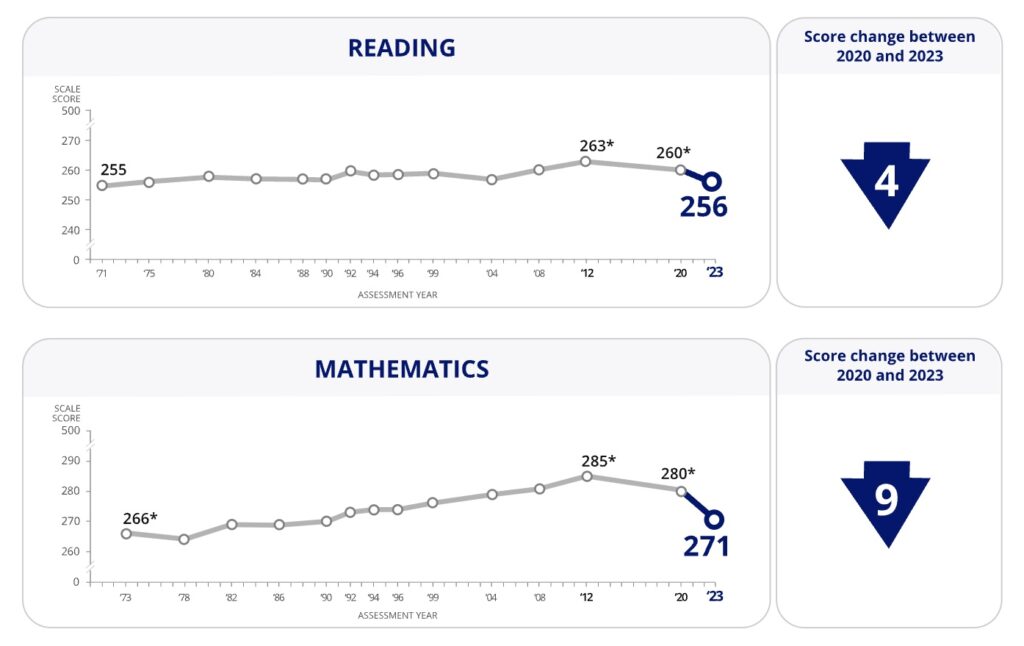There are no “green shoots’” of academic recovery emerging, with the Nation’s Report Card showing the largest-ever decline in math scores by 13-year-old students.
The average math score for 13-year-olds fell 9 points between 2019‒20 and 2022‒23 on long-term National Assessment of Educational Progress testing conducted late last year, according to data released Wednesday. And with the average reading score slipping by 4 points over the same time period, the testing reveals “signs of risk for a generation of learners,” said Peggy G. Carr, commissioner of the National Center for Education Statistics, which conducts the assessments.
“The ‘green shoots’ of academic recovery that we had hoped to see have not materialized, as we continue to see worrisome signs about student achievement and well-being more than two years after most students returned for in-person learning,” Carr said in a statement. “We are observing steep drops in achievement, troubling shifts in reading habits and other factors that affect achievement, and rising mental health challenges alongside alarming changes in school climate.”
More from DA: Teacher stress is returning to normal. Here’s why some still may leave.
Math scores for 13-year-olds had been rising substantially and reading scores more modestly until about 2012, when students began a regression that has now lasted more than a decade and accelerated during the COVID pandemic. These assessment results are particularly concerning as the progress students make in middle school can have a lifelong impact, adds Dan McGrath, the Center’s acting associate commissioner.
The Report Card uncovered some troubling K12 trends beyond the plummeting scores, including a decline in students taking algebra and pre-algebra. A little more than one-third of 13-year-olds were in an algebra class in 2012, compared to 24%in 2023. More students are now taking regular mathematics, the data shows. On the literacy side, about one-third of 13-year-olds said in 2023 that they “never or hardly ever” read for fun compared to the 22% who reported the same in 2012.

“Aside from its academic effects, reading opens the mind and the heart to new ways of seeing and thinking about the world,” Carr pointed out. “Many of our young people will never discover latent passions or areas of interest without reading broadly on their own time.”
A closer look at reading and math scores
The average reading score (256) for 13-year-old students was 4 points lower in 2023 than in 2020 and seven points lower than in 2012 and about the same as in 1971. The average math score (271) for 13-year-old students was 9 points lower in 2023 than in 2020 and 14 points lower than in 2012 but 5 points higher than in 1973.
Here’s a closer look at the declines between 2020 and 2023:
Reading
- Scores for Black students declined 7 points; 8 points for students of two or more races, and 4 points for white students. Scores for Hispanic students, American Indian/Alaska Native students, and Asian students were flat.
- Reading scores fell across the board, with declines for students at the 10th, 25th, 50th, 75th, and 90th percentiles.
- The reading score for students at the 10th percentile in 2023 (202) was lower than the reading score for students at the 10th percentile in 1971 (208).
Mathematics
- Scores declined by 13 points for Black students (from 256 to 243), 10 points for Hispanic students (from 267 to 257), 20 points for American Indian/Alaska Native students (from 275 to 255), 8 points for students of two or more race (from 285 to 277), and 6 points for white students (from 291 to 285).
- Scores declined for male and female students and for students from all regions of the country.
- Scores fell for students in all percentiles.









